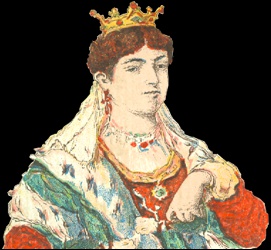 |
June
2018
|
|
|
June
started pleasantly with the Collectors Day at the National Playing Card
Museum in Turnhout, Belgium. A few days later a journey from hospital to
hospital started and there was little time and appetite to continue
sorting out of the rest of the LB collection.
|
|
Fortunately
we had already found some interesting decks to complete with the rest
cards and the choice was between this deck and the second Continental
Style deck by De La Rue. Both decks are rarely seen and the De La Rue
deck was a nice completion, as we already have the first Continental
Style deck (see our Deck of the Month in November 2012), but we had
never actually seen the other deck before. That made it worth sharing it
with you here. |
Louis Bausch had
added a small note with all the information about the deck in each sheet with
courts, aces and jokers. These notes are very helpful and usually have correct
information, but the information on the note that came with this deck was only
minimal. Usually LB mentioned references such as Braun or Cary or other sources,
but these were absent here. As maker LB had noted De La Rue, but with a question
mark. As title he gives "Romanian Royals" and as date 1880. The cards
measure 56 x 86 mm.
We have no idea how Louis came to note De La Rue as possible maker, nor how he
came to date the deck as 1880. When we started searching in our reference books
it became clear that the deck is pretty rare. It wasn't in the Fournier
catalogue, nor in one of the 38 Cartorama catalogues that we have here. The only
reference that we could find was in the Cary catalogue (II, p.83) where it is
mentioned as ROM 1, in fact the only Romanian deck in the catalogue. From the
description in IV p.93 it becomes clear that Cary didn't know anything about
this deck either. There's a short description of the courts and as date Cary
gives c1935.
|
Confronted
with a gap of 55 years in the dating of this deck, we were glad that our
deck has a Romanian tax stamp.
The text in the circle reads "REGIA MONOPOLURILOR STATULUT"
which can be translated as State Monopoly Authority. The value is 4 Lei.
For tax stamps we always check Peter Endebrock's site and there we found
a similar stamp, that was dated as c1920. However, in Peter's
description of this and other Romanian tax stamps the word presumably is
used and probably is even often used. |

|
With such
discrepancies and uncertainties we decided to take a look at the cards. There
are no indices, so our first observation is that Cary's dating is probably a bit
too far into the 20th century. The courts show different rulers from the
Romanian history. So we reflected on the reason for the publication in regard of
the historic developments in Romania. The Kingdom of Romania was proclaimed in
1881. Perhaps Louis has based his dating on this event. However, not long after
the end of WW I three regions with a large Romanian speaking population decided
to join the Kingdom of Romania and form a "Greater Romania". This
could have been a reason to highlight some of the historic figures that have
been responsible for the founding of Romania in a pack of cards. And...... it
would be confirmed by the tax stamp, "probably around 1920".
So, who are the
depicted historical figures?
 |

|
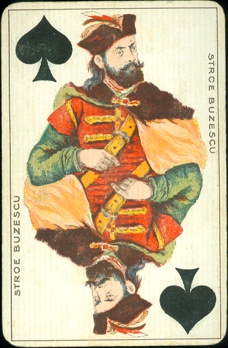
|
|
Bogdan Voda
(Voivode Bogdan) was the first voivode (warlord) of Moldavia. Voivode
later became a synonym for Prince in the Romanian territories. Although he
was originally from the Hungarian region of Maramures, his disloyalty to
the Hungarian King Louis I made him leave that region to conquer Moldavia,
that was ruled by a vasal of Louis I, in the early 1360's. His reign
marked Moldavia as an independent principality.
Elena Doamna was the semi-official title of Elena Cuza (1825-1909). She
became the princess consort of the United Principalities (Moldavia and
Wallachia) by her marriage to Prince Alexandru Ioan Cuza in 1844
Stroe Buzescu was a military leader under Michael the Brave (KH), who
fought many battle in Michael's army against the Ottoman Turks between
1590 and 1600. |
|
Michaiu
Viteazul (Michael the Brave) became the Prince of Wallachia in 1593,
Prince of Moldavia in 1600 and ruler of Transylvania in 1599. He is
considered one of the great heroes in the Romanian history, not only
because he broke with the rule of the Ottoman empire, but because he was
the first to unite the main parts of Romania into one reign. He was
assassinated in 1601.
His "queen" is in fact his daughter Florica.
Aprodul Purece is a descendant from the Molivesti, a boyar family.
Boyars are the highest ranking in the Moldavian aristocracy. His main
achievement was that he brought Stephan the Great (KD) a fresh horse
during a battle, for which he was rewarded with vast estates. |
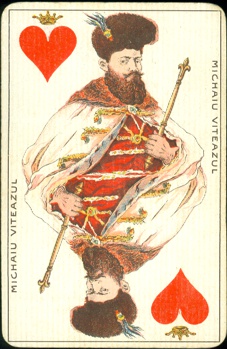 |
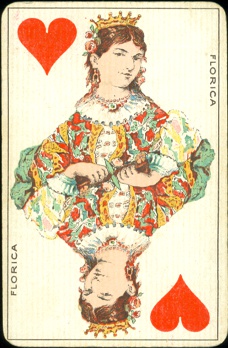
|
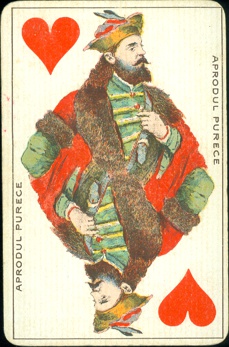
|
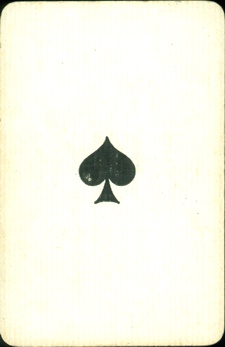


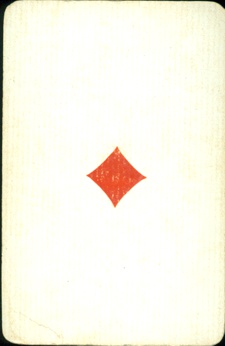
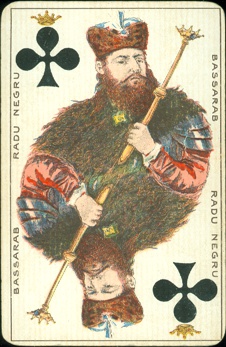 |

|

|
|
Radu Negru
is also known as Radu Voda. He was born in 1269 and is seen, according to
tradition, as the founder of Wallachia around 1290. It's not clear what
Bassarab means here. There's a Basarab I, who is possibly the son of Radu
Negru and who ruled Wallachia in the first part of the 14th century, but
we're not sure who's depicted here.
Doamna Bogdan Voda is the wife of Bogdan Voda. We think that Doamna as a
title refers to the status of queen or princess consort.
Logofetul Teut didn't bring a search result in wikipedia, so for now he
remains an unknown figure, but no doubt he has played a role in the
Romanian history. |
|
Stefan Cel
Mare (Stephen the Great) was voivode (Prince) of Moldavia from 1457 to
1504. Because his reign brought stability for a long time, he has -until
today- been seen as a great ruler and national hero.
Doamna Radu Negru was the wife of Radu Negru (KC).
Tudor Vladimirescu was the leader of a social and political rebellion,
known as the Wallachian Uprise of 1821. It became an attempt to remove
the boyar class from Wallachia, not directly aimed against the Ottoman
empire. Still, it's seen as the first awakening of a Romanian
nationalism. |
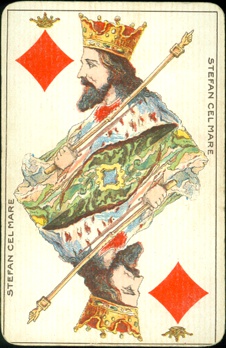 |

|
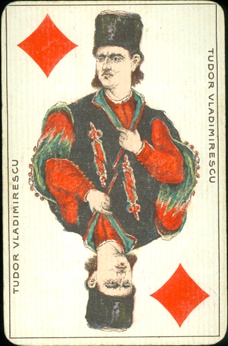
|
The deck consists of 52 cards. No joker was found.
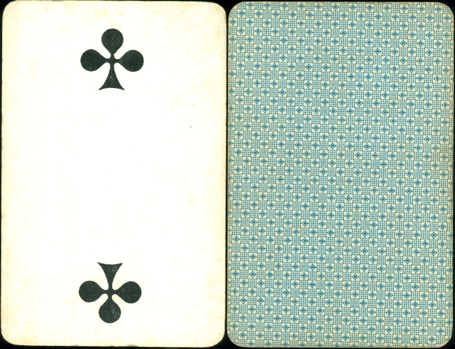
Leaves us with
the question about the manufacturer and publisher. The deck is printed in
lithography and the corners have been rounded. As we have never heard of a
(professional) Romanian printer and couldn't find any reference to the existence
of such a printer, we must assume that the printing wasn't done in Romania, but
elsewhere. But for us at this point anything goes. The generic back doesn't help
and even if we would recognize the pattern it's not conclusive. So De La Rue may
be possible, but a German or Eastern European printer just as well.
If the deck was printed abroad, then it would probably have been done in
commission by a Romanian company or organization. There was no box or wrapper, so we can only
hope that one of our visitors will be able to supply all the missing info. You
maybe?
BACK TO PRESENT
MONTH


















